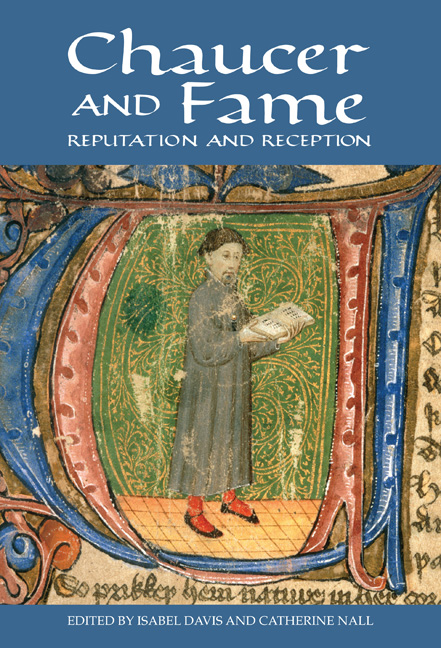79 results
The predictive role of symptoms in COVID-19 diagnostic models: A longitudinal insight
-
- Journal:
- Epidemiology & Infection / Volume 152 / 2024
- Published online by Cambridge University Press:
- 22 January 2024, e37
-
- Article
-
- You have access
- Open access
- HTML
- Export citation
Stephen H. Rigby and Siân Echard, eds. Historians on John Gower. Publications of the John Gower Society 12. Cambridge: D. S. Brewer, 2019. Pp. 580. $130.00 (cloth).
-
- Journal:
- Journal of British Studies / Volume 60 / Issue 4 / October 2021
- Published online by Cambridge University Press:
- 06 October 2021, pp. 968-969
- Print publication:
- October 2021
-
- Article
- Export citation
7 - Gower in Striped Sleeves: Mirour de l’Omme as Gower’s Early Humanism
-
-
- Book:
- Studies in the Age of Gower
- Published by:
- Boydell & Brewer
- Published online:
- 28 April 2020
- Print publication:
- 17 April 2020, pp 119-134
-
- Chapter
- Export citation
Chapter 26 - Crisis and Nation in Fourteenth-Century English Chronicles
- from Part IV - Genre
-
-
- Book:
- Medieval Historical Writing
- Published online:
- 19 December 2019
- Print publication:
- 28 November 2019, pp 450-466
-
- Chapter
- Export citation
9 - Political Literature and Political Law
- from Part II - Literary Texts
-
-
- Book:
- The Cambridge Companion to Medieval English Law and Literature
- Published online:
- 26 July 2019
- Print publication:
- 08 August 2019, pp 107-119
-
- Chapter
- Export citation
Chapter 2 - Chaucer’s Life and Literary ‘Profession’
- from Part I - Chaucer as Context
-
-
- Book:
- Geoffrey Chaucer in Context
- Published online:
- 24 June 2019
- Print publication:
- 11 July 2019, pp 14-24
-
- Chapter
- Export citation
Ingrid Nelson . Lyric Tactics: Poetry, Genre, and Practice in Later Medieval England. Middle Ages Series. Philadelphia: University of Pennsylvania Press, 2017. Pp. 214. $59.95 (cloth).
-
- Journal:
- Journal of British Studies / Volume 56 / Issue 4 / October 2017
- Published online by Cambridge University Press:
- 27 September 2017, pp. 876-877
- Print publication:
- October 2017
-
- Article
- Export citation
Tree Growth, Fruit Size, and Yield Response of Mature Peach to Weed-Free Intervals
-
- Journal:
- Weed Technology / Volume 21 / Issue 1 / March 2007
- Published online by Cambridge University Press:
- 20 January 2017, pp. 102-105
-
- Article
- Export citation
Simple Forms: Essays on Medieval English Popular Literature. Douglas Gray. Oxford: Oxford University Press, 2015. x + 268 pp. $95.
-
- Journal:
- Renaissance Quarterly / Volume 69 / Issue 4 / Winter 2016
- Published online by Cambridge University Press:
- 20 November 2018, pp. 1569-1571
- Print publication:
- Winter 2016
-
- Article
- Export citation
Chapter 11 - Imagining the literary in medieval English
- from IV - The discontinuities of English
-
-
- Book:
- Imagining Medieval English
- Published online:
- 18 December 2015
- Print publication:
- 25 January 2016, pp 210-238
-
- Chapter
- Export citation
Life in Words: Essays on Chaucer, the Gawain-Poet, and Malory. Jill Mann. Ed. Mark David Rasmussen. Toronto: University of Toronto Press, 2014. xxxix + 360 pp. $75.
-
- Journal:
- Renaissance Quarterly / Volume 68 / Issue 3 / Fall 2015
- Published online by Cambridge University Press:
- 20 November 2018, pp. 1126-1128
- Print publication:
- Fall 2015
-
- Article
- Export citation

Chaucer and Fame
- Reputation and Reception
-
- Published by:
- Boydell & Brewer
- Published online:
- 21 May 2021
- Print publication:
- 18 June 2015
Frontmatter
-
- Book:
- Chaucer and Fame
- Published by:
- Boydell & Brewer
- Published online:
- 21 May 2021
- Print publication:
- 18 June 2015, pp i-iv
-
- Chapter
- Export citation
Contents
-
- Book:
- Chaucer and Fame
- Published by:
- Boydell & Brewer
- Published online:
- 21 May 2021
- Print publication:
- 18 June 2015, pp v-vi
-
- Chapter
- Export citation
List of Illustrations
-
- Book:
- Chaucer and Fame
- Published by:
- Boydell & Brewer
- Published online:
- 21 May 2021
- Print publication:
- 18 June 2015, pp vii-viii
-
- Chapter
- Export citation
List of Contributors
-
- Book:
- Chaucer and Fame
- Published by:
- Boydell & Brewer
- Published online:
- 21 May 2021
- Print publication:
- 18 June 2015, pp ix-x
-
- Chapter
- Export citation
Index
-
- Book:
- Chaucer and Fame
- Published by:
- Boydell & Brewer
- Published online:
- 21 May 2021
- Print publication:
- 18 June 2015, pp 245-250
-
- Chapter
- Export citation
Chaucer Studies
-
- Book:
- Chaucer and Fame
- Published by:
- Boydell & Brewer
- Published online:
- 21 May 2021
- Print publication:
- 18 June 2015, pp 251-252
-
- Chapter
- Export citation
Acknowledgements
-
- Book:
- Chaucer and Fame
- Published by:
- Boydell & Brewer
- Published online:
- 21 May 2021
- Print publication:
- 18 June 2015, pp xi-xii
-
- Chapter
- Export citation
6 - Fame’s Penitent: Deconstructive Chaucer Among the Lancastrians
-
-
- Book:
- Chaucer and Fame
- Published by:
- Boydell & Brewer
- Published online:
- 21 May 2021
- Print publication:
- 18 June 2015, pp 103-126
-
- Chapter
- Export citation



